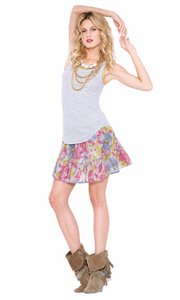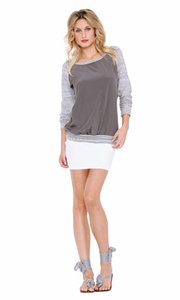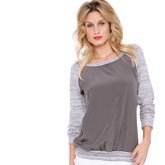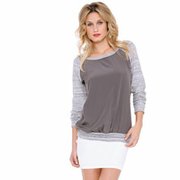Three Dots: The Local Advantage to Keeping Basics Fashion-Forward
Three Dots, which launched with a focus on fashion knit tops in 1995, is one of the most well-established makers of fashion basics, even as the category swells to include hot-and-heavy competition and retailers continue to struggle with the effects of the down economy. California Apparel News Manufacturing Editor Erin Barajas caught up with Sarah Angell, Three Dots’ executive vice president, to discuss the challenges and benefits of being “made in America,” the changing apparel industry and what the company is doing to stay ahead of the fashion basics market.What’s new at Three Dots?
We’re always experimenting with new fabrications. Pegah Anvarian, our designer, is a mix master, and she is always finding new ways to mix different fabrications, whether it’s pairing knits with knits, or knits with wovens. In general, we’re adding more wovens to the collection, and for Spring 2011 we are expanding our bottoms offerings. We’ve always included bottoms, but, going forward, we’ve added some casual, unstructured woven bottoms that reinvent the way we merchandise the collection. The bottoms—which include a slouchy crepe de chine cargo pant, a convertible skirt/dress, a ponti miniskirt, leggings, draped skirts and marble cotton jersey pants—allow women to wear Three Dots head to toe. The focus is on giving our customers the option to merchandise more of a collection look from us. We’re excited to be expanding that category, although we are still very much a top- and dress-driven collection. As one of the more established knit basics lines in the industry, how have you seen the category change over recent years?
Despite the economy, there continues to be an influx of competition, which just means that we have to work harder to have the best fabrics and the best quality. Quality is something we are known for. We also have to continually find ways to create interest and find the right balance of fashion and basics. It’s a bit of a juggling act in terms of getting the right merchandise mix. We deliver 12 months of the year and include 40-plus new styles every single month.How does having your clothing made domestically inform your business?
In 2008, we began adjusting our pricing and looked for ways to bring costs down. Being made domestically, we were able to find new quality contractors that saved us roughly between 5 and 10 percent without compromising the quality of our goods. In turn, we were able to pass those savings on to our customers—and that was appreciated by our customers. As the economy strengthens, we’ll hold at this [lower] price. We’ll add some more-expensive fabrications [if it makes sense] and is beautiful. Right now, nothing in our line retails for more than $198, but 70 percent of the collection retails for less than $100.What are some of the challenges and benefits of producing in the United States?
Less than 1 percent of our line is produced overseas. Everything else is produced locally. Being made domestically helps with quality control, which is essential to us. Our owner, Sharon Lebon, and the entire team, is obsessed with quality. We’re very hands-on in the production process. [Domestic manufacturing] also helps us with our turnaround time, which is, on average, nine to 10 weeks from closing to delivery—though existing styles can be turned around in as little as two weeks, which we do fairly frequently for some major stores. In the last couple of years, retailers have begun to say that they do care about apparel that is made in America. They respond to that, and they appreciate it.
The challenges [of producing domestically] are that we can’t achieve some prices while producing here. On a very rare occasion, maybe one piece in a 140-piece collection will be produced in Mexico, but we prefer to do everything we can locally. There are plenty of great contractors within the Los Angeles area that we can work with. What’s driving sales now?
Thanks to the popularity of the denim legging, leggings and skinny jeans, anything in a longer tunic silhouette sold very well for us at the wholesale level for Fall 2010. Women don’t want to expose their bottoms, so these long bodies in any variation on the tunic work well, and we’re continuing with them going forward.
Fall 2010 just hit, and, so far, we’re excited about a loose rayon jersey capsule that includes a long-sleeve top with an overlay, a mock-neck tunic and a drape-front tunic. Right now, it’s about having the right fashion at the right price.

























